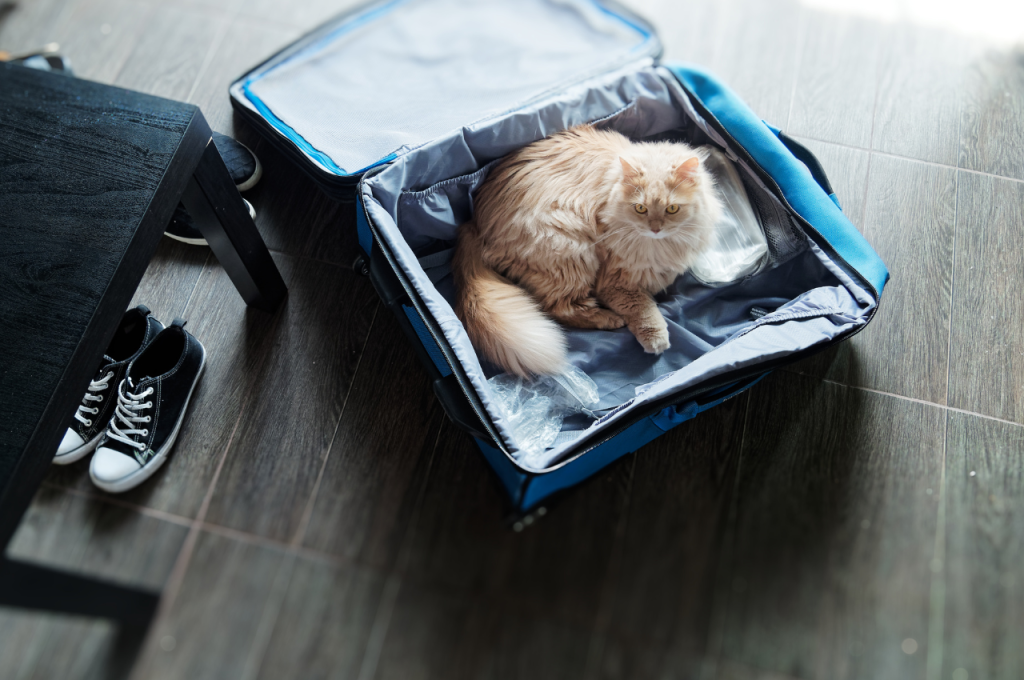To transport a cat long distance, use a secure and well-ventilated pet carrier. Place familiar bedding and toys inside to keep the cat comfortable during the journey.
Additionally, ensure the cat is microchipped and has a collar with an ID tag. It’s also important to schedule regular breaks for the cat to stretch and use the litter box. Moreover, keep the cat’s routine as normal as possible to reduce stress. Furthermore, consult with a veterinarian for any necessary medications or sedatives to keep the cat calm during travel. In addition, make sure to have a recent photo of the cat in case it gets lost during the journey. By following these tips, you can safely transport your cat long distances while keeping them comfortable and secure.
Preparing Your Cat for The Journey
Preparing your cat for a long-distance journey requires careful planning and consideration. Ensure their comfort and safety by providing a secure carrier, familiarizing them with the space, and making necessary preparations for food, water, and bathroom breaks along the way.

Health Check-up
Before a long-distance trip, ensure your cat is healthy by visiting the veterinarian for a check-up.
Familiarizing Your Cat with The Carrier
Introduce the carrier to your cat gradually, making it a comfortable and familiar space.
Choosing The Right Carrier
When it comes to transporting your cat long distances, choosing the right carrier is crucial. The carrier should provide comfort, security, and safety for your feline friend throughout the journey. Here’s what to consider when selecting the ideal carrier for your cat’s long-distance travel.
Types of Carriers
There are various types of carriers available for transporting cats long distances. The most common options include soft-sided carriers, hard-sided carriers, and backpack-style carriers. Each type has its own advantages, so it’s essential to choose one that best suits your cat’s needs and your mode of transportation.
Comfort and Security Features
When selecting a carrier for long-distance travel, prioritize comfort and security features. Look for carriers with ample ventilation, a secure locking mechanism, and a cozy interior to ensure your cat feels safe and relaxed during the journey. Additionally, consider carriers with padded straps and ergonomic design for your own comfort while carrying the carrier.
Planning Your Route
Before embarking on a long-distance journey with your cat, it’s crucial to plan your route carefully to ensure a smooth and stress-free trip.
Rest Stops
Plan regular rest stops along your route to allow your cat to stretch, use the litter box, and stay hydrated.
Pet-friendly Accommodations
Research and book pet-friendly accommodations in advance to ensure a comfortable stay for you and your feline companion.
On The Road: Safety Tips
When transporting your cat long distance, it’s important to prioritize their safety and well-being throughout the journey. Taking precautions and following these safety tips will help ensure a smooth and stress-free trip for both you and your feline companion.
Securing The Carrier in The Vehicle
Properly securing the carrier is crucial to prevent any accidents or injuries while on the road. Follow these steps to secure the carrier in your vehicle:
- Choose a carrier that is sturdy and well-ventilated to provide comfort for your cat during the journey.
- Place the carrier on a flat surface in the vehicle, such as the back seat or the floor behind the front seats.
- Secure the carrier using the seatbelt or by using straps designed specifically for securing pet carriers in vehicles.
- Make sure the carrier is positioned in a way that it won’t slide or move during sudden stops or turns.
By properly securing the carrier, you can minimize the risk of accidents and keep your cat safe and secure throughout the journey.
Monitoring Your Cat’s Well-being
While on the road, it’s essential to keep a close eye on your cat’s well-being. Here are some tips to ensure your cat stays comfortable and safe:
- Monitor the temperature inside the vehicle. Keep it at a comfortable level to prevent overheating or chilling.
- Provide fresh water for your cat at regular intervals to keep them hydrated.
- Do not open the carrier while the vehicle is in motion. This can cause your cat to escape or get injured.
- Keep the noise level inside the vehicle low to reduce stress and anxiety for your cat.
- Check on your cat regularly during rest stops to ensure they are calm and comfortable.
By monitoring your cat’s well-being and addressing their needs during the journey, you can help them feel secure and reduce any potential stress or discomfort.
Feeding and Hydration
Proper feeding and hydration are crucial when transporting a cat long distances. Make sure to pack enough food and water for the journey, and consider using a spill-proof bowl to prevent spills and leaks. It’s also important to avoid overfeeding your cat, as motion sickness can be a concern during travel.

Feeding and hydration are essential aspects to consider when transporting your cat long distance. Proper nutrition and hydration can help your feline friend stay calm and comfortable throughout the journey. Here are some tips on what to feed and how to keep your cat hydrated during travel.
What to Feed
It’s best to stick to your cat’s regular diet as much as possible during travel to avoid upsetting their stomach. However, it’s recommended to feed them a small meal a few hours before the trip to prevent hunger and reduce the risk of motion sickness. If you plan to travel for an extended period, pack enough food for your cat’s trip, including some extra in case of delays. Dry food is a convenient option, but wet food can provide additional hydration.
Keeping Your Cat Hydrated
Staying hydrated is vital for your cat’s health and comfort during travel. Make sure to provide them with plenty of water before and during the trip. It’s recommended to bring a travel-friendly water bowl and refill it as needed. You can also consider offering your cat wet food, which can provide additional hydration. If your cat is hesitant to drink water, you can try adding a little bit of tuna juice to their water bowl to entice them.
In conclusion, feeding and hydration are crucial components of transporting your cat long distances. By following these tips, you can ensure your feline friend stays comfortable and healthy throughout the journey.
Handling Anxiety and Stress
Transporting a cat long distance can be a source of anxiety and stress for both the cat and the owner. However, with proper preparation and care, you can handle this situation smoothly. Ensure the cat has a comfortable carrier, provide familiar smells and objects, and make regular stops for breaks and reassurance during the journey.
Calming Techniques
When it comes to handling anxiety and stress during long-distance cat transportation, there are several effective calming techniques that can help your feline companion feel more at ease.
- Provide a Comfortable Carrier: Ensure your cat’s carrier is spacious, secure, and well-ventilated. Line it with a soft blanket or bedding familiar to your cat to create a sense of familiarity and comfort.
- Use Pheromone Sprays: Consider using pheromone sprays or diffusers designed specifically for cats. These products release calming pheromones that can help reduce stress and anxiety in felines.
- Create a Peaceful Environment: Keep the environment around your cat as calm as possible. Avoid loud noises, excessive movement, and other stress-inducing factors during the journey.
- Play Soothing Music: Playing soft, classical music or specially designed cat relaxation tracks can have a calming effect on your cat. The rhythmic sounds can help distract from the stress of travel.
- Try Calming Treats or Supplements: Consult your veterinarian about the possibility of using calming treats or supplements for your cat. These products often contain natural ingredients that promote relaxation.
When to Consult a Vet
While these calming techniques can be beneficial for most cats, there are situations where professional veterinary guidance may be necessary. It’s important to recognize when it’s time to consult a vet during the long-distance transportation of your cat.
- Severe Anxiety Symptoms: If your cat exhibits severe anxiety symptoms such as excessive panting, vomiting, or aggression, it’s crucial to seek veterinary advice.
- Underlying Medical Conditions: Cats with pre-existing medical conditions may require additional support during travel. Consult your vet to ensure your cat’s specific needs are addressed.
- Prescription Medication: In some cases, your vet may prescribe anti-anxiety medication to help your cat cope with the stress of long-distance transportation. Always follow your vet’s instructions carefully.
- Behavioral Issues: If your cat has a history of behavioral issues or is prone to excessive stress, your vet can provide guidance on behavior modification techniques or recommend a professional animal behaviorist.
Remember, every cat is unique, and what works for one may not work for another. It’s essential to observe your cat closely and consult a veterinarian if you have any concerns about their well-being during long-distance travel. By implementing appropriate calming techniques and seeking professional advice when necessary, you can help ensure a smoother and less stressful journey for your beloved feline companion.
Breaks and Exercise
When transporting a cat long distance, it’s essential to schedule regular breaks and provide opportunities for exercise to ensure their well-being during the journey. This helps to reduce stress and anxiety while allowing the cat to stretch their legs and use the litter box. Planning breaks and exercise into the travel schedule is crucial for a smooth and comfortable trip.
Scheduling Breaks
To prevent your cat from feeling overwhelmed during a long-distance journey, it’s important to schedule regular breaks. Plan to stop every 3-4 hours to allow your cat to stretch, use the litter box, and have a drink of water. Keep the breaks short to avoid prolonging the journey unnecessarily. This not only benefits your cat’s physical health but also contributes to their mental well-being.
Leash Training
Leash training your cat before a long-distance trip is essential for their safety during exercise breaks. Start the training process well in advance, allowing your cat to become comfortable wearing a harness and walking on a leash. This training helps to prevent escape attempts and ensures that your cat can safely explore their surroundings during breaks.
After The Journey
After the journey, it’s essential to help your cat acclimatize to its new surroundings and ensure it’s in good health.

Acclimatizing to New Surroundings
Help your cat get used to its new environment by setting up a quiet, safe space with familiar items like their bed, toys, and scratching posts. Introduce them to one room at a time, gradually expanding their access to the new space to prevent overwhelming them.
Post-travel Check-up
After the long journey, schedule a visit to the vet for a thorough check-up to ensure your cat is healthy and has not been affected by the travel stress.
- Observe your cat’s behavior for any signs of distress or illness.
- Check for any unusual physical symptoms or changes in appetite and water intake.
- Discuss any concerns with your vet to address potential issues early on.
Conclusion
Transporting a cat long distance can be a stressful experience for both you and your furry friend. By following the tips outlined in this blog post, you can ensure a safe and comfortable journey for your cat. Remember to prepare in advance, take necessary precautions, and provide plenty of love and attention throughout the trip. With the right approach, you can make your cat’s journey a positive experience.
